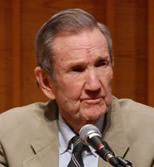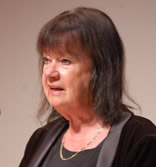SCHILLER INSTITUTE CONFERENCE
Building A World Land-Bridge:
Realizing Mankind's True Humanity
Thursday, April 7, 2016, 9:00am - 9:30pm
NEW YORK CITY
Program and video
Invitation
Thursday's Schiller Institute Conference in New York City, "Building a World Land-Bridge—Realizing Mankind's True Humanity," marked a success for Lyndon LaRouche's idea. Although further and fuller reports will follow, and this one only reflects a part of the proceedings, that much can already be said with certainty.
 |
 |
|
EIRNS/Stuart Lewis
former U.S. Attorney General (1966-67) Ramsey Clark (left), and Schiller Institute founder, Helga Zepp LaRouche |
||
Helga Zepp-LaRouche opened the conference with a comprehensive and inspiring address entitled, "Beyond Geopolitics and Polarity: A Future for the Human Species," in which she laid bare the immediate threat of annihilating war, and showed that the idea of the World Land-Bridge, which she developed with her husband during the period of the collapse of the Warsaw Pact, provides the only durable guarantee for peace. She went on to outline a dialog of civilizations in which each of the world's civilizations is represented by the cultural high-points of its history, such as Germany's Weimar Classic, and the United States as it was first conceived by Benjamin Franklin and Alexander Hamilton.
Helga was followed by former U.S. Attorney General (1966-67) Ramsey Clark, who wove his own long experience into an account of recent world history which underlined the alternative to the war policies of most of the post-Kennedy U.S. Administrations.
The next speaker was a truly unique figure from China, that nation's leading professor of journalism and the leader of much else as well, Li Xiguang. Professor Li has led a decades-long pilgrimage on behalf of the Silk Road,—across Central Asia, and down each of the three North-South routes, and back again. He has led no fewer than 500 of his students on this pilgrimage with him since 1990, and has written two volumes on the New Silk Road. Although his goals for the Silk Road are not religious goals—they are the same as those of the LaRouche movement—Professor Li models himself on the great Chinese cultural heroes, the Buddhist monks Xuanzang (602-664) and his predecessor Faxian (337-422). Both made extensive and arduous trips along the Silk Road, and brought back the first real knowledge of much of world civilization to China, including most especially Sanskrit language and culture and Buddhist scriptures in the original.
Xuanzang spent no less than 16 years on this voyage, and returned with 600 Indian texts. In 646, at the Tang-Dynasty Emperor's request, he completed his 12-volume work, "Great Tang Records on the Western Regions," which has become one of the primary sources for the study of medieval Central Asia and India, and the basis for the Sixteenth Century novel "Journey to the West," one of the Four Great Classical Chinese Novels.

EIRNS/Stuart Lewis
Thursday's afternoon panel, "New Scientific Frontiers." From left to right, Tom Wysmuller, Jason Ross, Dr. Feng Hsu, Kesha Rogers and Dennis Speed at the podium. |
The afternoon session which highlighted the space program, which Kesha Rogers opened with a vivid presentation, will be reported later. The climax of that session was a question-and-answer session with Lyndon LaRouche by Skype connection. LaRouche led most of the questions back to the cardinal question that changes in the physical system, and in the future of mankind, are created by the thinking human mind itself; no animal can do this. Mankind is organized by his own acts of this type; it is these which lead either to failure or to success. This is the mind of the true scientist, of which Einstein is an example. But this account is only a characterization; the actual answers should be studied in detail.
Attendance exceeded 200, not including the core membership. About a dozen foreign countries were represented from Europe, Asia and Africa, whether through diplomats, cultural associations or in other ways. Many musicians attended, and at least five people from the Brooklyn church where we performed the Messiah during Easter. This may have been the largest conference we have ever held.
What must be said in conclusion is that this conference marked a victory for an idea of Lyndon LaRouche's: that of the Manhattan Project which he unveiled in October, 2014. Yet at that time, as Einstein famously wrote of Kepler in 1930 at the third centenary of his death, he was "supported by no one and understood by very few." Lyndon LaRouche, the inventor of the Strategic Defense Initiative, and later the inventor, with his wife, of the Eurasian Land-Bridge, had once more invented a new and wholly different original idea. Again it has proven true.
